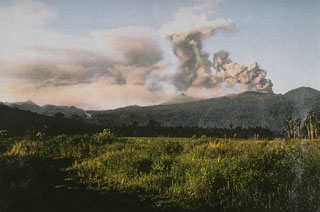Report on Dukono (Indonesia) — 17 November-23 November 2021
Smithsonian Institution / US Geological Survey
Weekly Volcanic Activity Report, 17 November-23 November 2021
Managing Editor: Sally Sennert.
Please cite this report as:
Global Volcanism Program, 2021. Report on Dukono (Indonesia) (Sennert, S, ed.). Weekly Volcanic Activity Report, 17 November-23 November 2021. Smithsonian Institution and US Geological Survey.
Dukono
Indonesia
1.6992°N, 127.8783°E; summit elev. 1273 m
All times are local (unless otherwise noted)
Based on satellite and wind model data, the Darwin VAAC reported that on 17 November ash plumes from Dukono rose to 2.1 km (7,000 ft) a.s.l. and drifted NE and ENE. Dense white plumes rose as high as 500 m and drifted NW, W, and SW during 18-23 November according to PVMBG. The Alert Level remained at 2 (on a scale of 1-4), and the public was warned to remain outside of the 2-km exclusion zone.
Geological Summary. Reports from this remote volcano in northernmost Halmahera are rare, but Dukono has been one of Indonesia's most active volcanoes. More-or-less continuous explosive eruptions, sometimes accompanied by lava flows, have occurred since 1933. During a major eruption in 1550 CE, a lava flow filled in the strait between Halmahera and the N-flank Gunung Mamuya cone. This complex volcano presents a broad, low profile with multiple summit peaks and overlapping craters. Malupang Wariang, 1 km SW of the summit crater complex, contains a 700 x 570 m crater that has also been active during historical time.
Sources: Pusat Vulkanologi dan Mitigasi Bencana Geologi (PVMBG, also known as CVGHM), Darwin Volcanic Ash Advisory Centre (VAAC)

